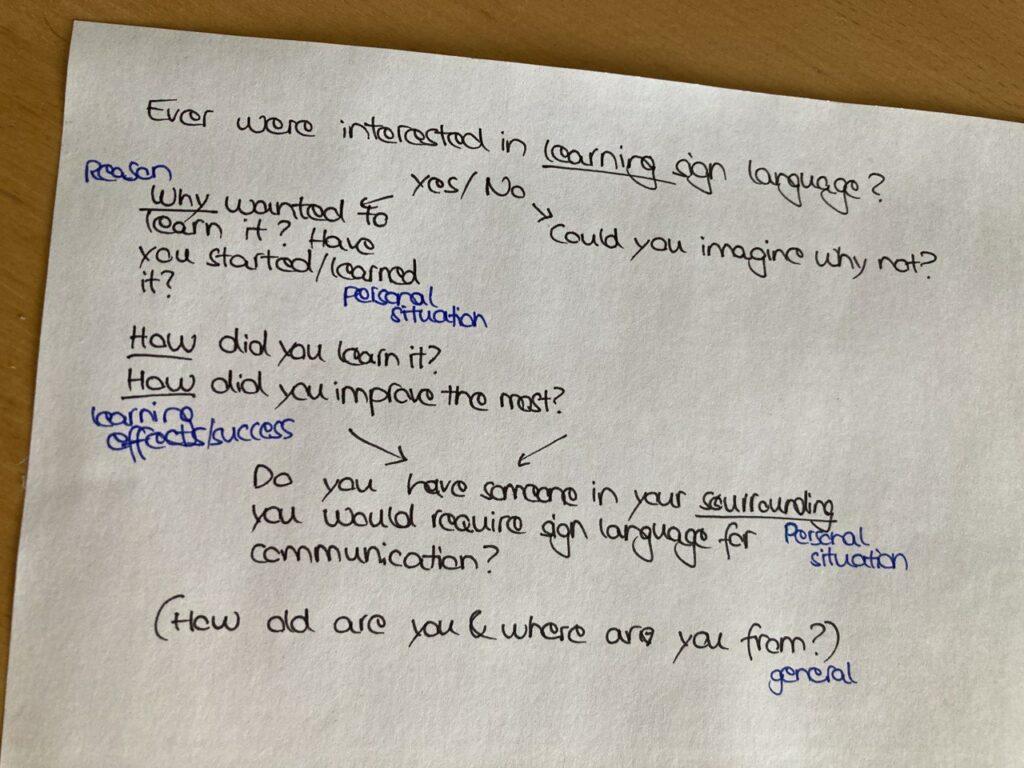I asked around for some information through qualitative research about who is willing or has thought of learning the sign language. Basically to get to know if there is an interest in getting educated in and on sign language or if there is no need for such a tool. The structure of the questionary did not follow a concrete form and I was adjusting my follow up questions by the answers which were given to me.

The following questions appeared most of the times:
Were you ever interested in learning sign language? Yes/No
if yes: Why did/do you want to learn it? open answer
if did not learn it yet: Why did you not learn it yet? open answer
How did you learn it (instructor, YouTube, apps, other options) open answer
How did you improve the most? open answer
Do you generally learn new languages and if so how? open answer
Do you have someone in your surroundings you would require to use sign language to communicate with them? Yes/No and open answer
How old are you and where are you from? open answer
Outcome
The following answers give a short insight into the interest situation. The presented persons refer to the people interested in sign language and one participant who has learned it.
Person A, 27 years old female:
Her friend wrote a paper about the topic of sign language accompanied by a photo exhibition. She became interested in the topic trough that but she did not start to learn it because she would not know with whom she might practice speaking without letting the learned signs fall into oblivion. She is planning on learning the most important signs like “hello”, “how are you?” and other most common conversation pieces on her own so that she can at least communicate like in the other languages with these simple sentences. Because she is interested in the topic she thinks the tool would be helpful to get to know a few sentences but thinks it is difficult if the person who wants to learn it does not have someone in the surrounding to talk to in sign language because there is no motivation if you do not know if you will really deploy it to communicate with another person.
Person B, 52 years old female:
She thought about learning it about a hundred times since she was a child. Her aunt is deaf and she was willing to learn it, not just because of her aunt but in general because she is interested in the language, but has never done it. Her aunt can read lips and person B learned to articulate clearly to make the communication easier so it was not necessary to learn it even though she had somebody in her surrounding she could communicate through sign language. She explains that her laziness is in her way even when trying to learn spoken languages like English.
Person C, 25 years old female:
She is interested in the language, since you can communicate with many people all over the world as well because she is interested to learn a language only based on movements, gesture and mimic. She has no one in her surroundings where she would require to use sign language. So far, she has only learned spoken languages because she really loves the melodic sound of the different languages which she has learned mostly in school and in university. She improved the most by spending time in the countries where she had to speak the language.
Person D, 26 years old male:
Has learned sign language when he was 18 because he thinks it is important to know how to communicate with all people and sign language is in his opinion a really universal language. He knew someone who was communication trough sign language and used to work with Org which in his opinion is always useful.
He learned a couple of gestures and hand positions with the help of YouTube and a foundation that teaches the language. He did not improve much because he did not practice.
Conclusion
In conclusion the questionary helped me as a first little step to understand the position and situation of possible users and which difficulties or behavior stands in the way. Most of the time people are interested but their own laziness or absence of the need to learn it because there is no one in their community who can not speak spoken language as well as if they would be interested in it and learn it they would not have somebody to exercise it with. It is clear that both people of unspoken and people of spoken languages stay in their own communities and communicate with each other as it is a lot easier and the empathy is higher most of the times. This is why the persons I have asked for this questionary as well and which were not even interested in learning sign language were naming reasons like that as well because they see no need for it and do not need it for communication. In order to not forget the whole picture it could be possible to implement different features into the tool that stand against these difficulties for example a buddy-feature where people can connect and exchange. Which of the solutions for such problems will be necessary or helpful will be discussed within the next months after more insight through the next steps as this questinary shall not be interpreted as representative due to the number, gender and age of the participants.
Next steps will be needed like a more precise as well as quantitative questionary to get to know the needs from actual users who have to learn it, different approaches in learning and many more to get as much information as possible.